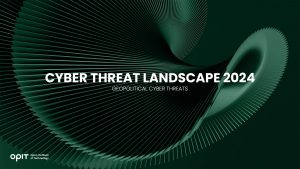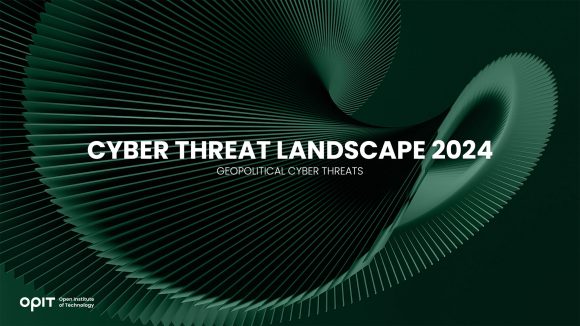There are currently few things that worry CEOs worldwide as much as geopolitics. Cybersecurity is undoubtedly one of them. But what happens when you combine geopolitical conflicts and cyber threats?
Geopolitical cyber threats, that’s what.
This lethal combination threatens to disrupt economies, destabilize governments, and shatter global stability. That’s why it must be met with an ironclad cybersecurity strategy.
But what does that strategy entail?
That’s for Tom Vazdar and Venicia Solomons to answer. Tom is the chair of the Master’s Degree in Enterprise Cybersecurity program at the Open Institute of Technology (OPIT). Venicia is a seasoned cybersecurity architect and advocate who has rightfully earned the nickname “the Cyber Queen.”
Check out OPIT degrees
-
Career aligned
-
Fully Online
-
EU-accredited institution
Here’s what these two esteemed cyber professionals have to say about geopolitical cyber threats in their highly informative master class titled “Cyber Threat Landscape 2024: Navigating New Risks.”
What Are Geopolitical Cyber Threats?
Geopolitical threats refer to cyberattacks (or campaigns) driven by political motives. These attacks are often conducted by state-sponsored actors and have a specific strategic goal in mind.
For instance, Iran-backed hackers have recently been targeting U.S. water systems, aiming to disrupt Israeli-made equipment globally. This example also perfectly illustrates the targets of geopolitical cyberattacks – critical infrastructure, government systems, military networks, and other relevant entities.
But don’t jump to conclusions – the private sector isn’t immune to such attacks.
Cybercriminals have also targeted private companies to steal intellectual property, disrupt operations, or extort money. However, what differentiates these attacks from other cyberattacks is the motivation behind them.
Whether it’s through espionage, sabotage, or disinformation, geopolitical cyber threats always aim to achieve a political or strategic advantage for the attacker.
How Do State-Sponsored Cyber Threats Differ From Other Cyberattacks?
In their master class, Tom and Venicia specifically focus on state-sponsored cyber threats, even though they aren’t the only type of geopolitical cyber threats. Why? Because they’re the most advanced and sophisticated cyber threats.
As Venicia puts it, state-sponsored cyberattacks involve “specialist hacking techniques,” “stealthy behavior,” and “stealthy execution.” That’s why the consequences of these attacks are often only seen after significant damage has been done.
This leads us to another distinctive characteristic of state-sponsored cyberattacks – they typically involve long-term execution.
You see, other forms of cyberattacks usually want to reach their goal as soon as possible. For instance, a ransomware attack will infiltrate your system, and the hacker will ask for ransom straight away.
A state-sponsored cyberattack, on the other hand, usually plays the long game. That’s why they’re considered an advanced persistent threat (APT). Remaining undetected for a long time allows these threats to collect lots of critical data and perform long-term espionage.
Tom adds that the goal of these cyberattacks is another important distinction. As mentioned, they usually have a strategic goal in mind. “Regular” cyber threats, in contrast, typically only aim for financial profit.
Why Is Geopolitical Cybersecurity Important?
For the most part, traditional warfare was limited to three battlefields – the land, the air, and the sea. However, as Tom points out, two vital battlefields have joined the fray – space and cyberspace.
Sure, threats in cyberspace aren’t overtly visible like those on land, air, or sea. However, they can be just as devastating, if not more so – especially if they’re geopolitical cyber threats.
Here’s how Tom and Venicia break down the importance of geopolitical cybersecurity.
Protecting Against Espionage
As mentioned, espionage is one of the leading types of geopolitical cyberattacks. Since espionage aims to collect as much valuable information as possible, these attacks are typically highly refined, which allows them to remain undiscovered for months on end.
Venicia points out that the recent geopolitical tensions have led to increased cyber espionage. That’s what makes solid geopolitical cybersecurity more important than ever. Let one intruder into your network, and you’re essentially giving away all your classified information (past, present, and future).
Avoiding Manipulation
2024 is an election year. This means that “influence operations, disinformation operations, [and] deep fake operations” will run more rampant than ever, as Tom warns. Ultimately, these operations aim to shape public opinion and undermine trust in democratic institutions. These outcomes are never desirable, let alone during such a crucial time.
That’s where cybersecurity comes into play.
These measures help secure digital platforms, detect (and remove) false information, and (in this specific scenario) safeguard electoral systems.
Protecting the Economy
As mentioned, geopolitical cyberattacks aren’t typically done for financial gain. However, they can still cause massive financial losses. How? By targeting “public organizations and private entities that make a large contribution to a country’s economy,” as Venicia explains.
And a world that’s still reeling from the effects the COVID-19 pandemic had on the global economy can’t possibly handle another major disruption. That’s why any similar threat should never be taken lightly.
How to Combat Geopolitical Cyber Threats
Now that you know why geopolitical cyber threats must be combatted, let’s discuss how this can be done.
Keep All Aspects in Mind
There are numerous factors that go into protecting against geopolitical cyber threats. But for this protection to actually work, all these factors must be considered when devising a defense strategy.
For starters, this means protecting all critical infrastructure sectors. Tom lists just some of them –financial services, healthcare and public health, and transportation systems. However, one thing applies to all critical infrastructure sectors – they aren’t “independent islands,” as Tom puts it.
They’re all part of a larger ecosystem.
Each sector can only be protected if there’s a holistic approach to cybersecurity, one that considers interdependencies between sectors and the potential cascading effects of cyber disruptions. This way, in case of a cyberattack, every sector can provide support and respond effectively to minimize the impact.
Foster Collaboration
The collaborative approach shouldn’t only apply to critical infrastructure sectors. All stakeholders, including government agencies, cybersecurity experts, and the private sector, must work together to address geopolitical threats effectively.
This collaboration can take many forms.
However, Tom highlights the three most important ones on the global level – sharing intelligence, developing international norms and agreements, and establishing cybersecurity alliances.
Our experts list some of the most useful alliances and resources in this regard:
- The No More Ransom Project helps organizations combat ransomware attacks by providing decryption keys, thus returning their vital information.
- Public-Private Partnerships (PPPs) worldwide allow for sharing cyber threat intelligence among industry partners to improve defenses collectively.
- The Budapest Convention on Cybercrime sets out international standards for combating cybercrime, promoting cooperation among countries to tackle cyber threats effectively.
Focus on Critical Infrastructure
By now, one thing’s clear – protecting critical infrastructure against geopolitical cyber threats is paramount.
According to Tom, collaboration plays a key role here as well. In his words, “The only way to protect [critical infrastructure] is that collaborative effort between government and the private sector because they cannot go without each other; they have to work together.”
Implement a Robust Cybersecurity Framework
A comprehensive and collaborative approach to combating geopolitical threats is just the preamble. The implementation of a robust cybersecurity framework is where the actual protection starts. Of course, these systems should be based on the intelligence collected through collaboration and education.
However, the system itself is just as important. After all, protecting critical infrastructure and other elements of similar importance requires more than just traditional anti-virus software!
According to Tom, a comprehensive cybersecurity framework will comprise four elements – threat detection, response tools, regular security assessments, and training. The specifics will vary by organization, and every relevant employee should be familiar with them.
Tom also emphasizes the importance of adopting a multi-layer approach to cybersecurity defenses. This way, even if one layer is breached, others will provide protection and prevent a total collapse of the system.
Stay Vigilant
Organizations should always be on the lookout for an uptick in suspicious activities, especially during times of geopolitical conflicts. This vigilance includes monitoring network traffic for anomalies, conducting regular security audits, and staying on top of the latest cyber threats and—let’s face it—the latest geopolitical conflicts.
Train Your Employees
The importance of thorough cybersecurity education can’t be understated. After all, employees are usually the first line of defense against cyber threats. So, they should be trained to handle the information system properly within the organization. They should know what to do and what not to do before, during, and after a geopolitical cyberattack.
However, there’s another type of employee crucial for the strength of cybersecurity within an organization – cybersecurity professionals themselves.
These individuals must be on top of their game at all times. One way to ensure this is to only hire professionals with ample experience and education. For instance, completing a renowned Master’s program like OPIT’s Enterprise Cybersecurity should be a huge green flag for any employer. It signals a strong commitment to cybersecurity excellence and a deep understanding of the latest trends and techniques in the field.
Invest in the education and professional development of your employees, and you stand a chance against the ever-evolving landscape of cyber threats, geopolitical and beyond.
Check out OPIT degrees
-
Career aligned
-
Fully Online
-
EU-accredited institution






